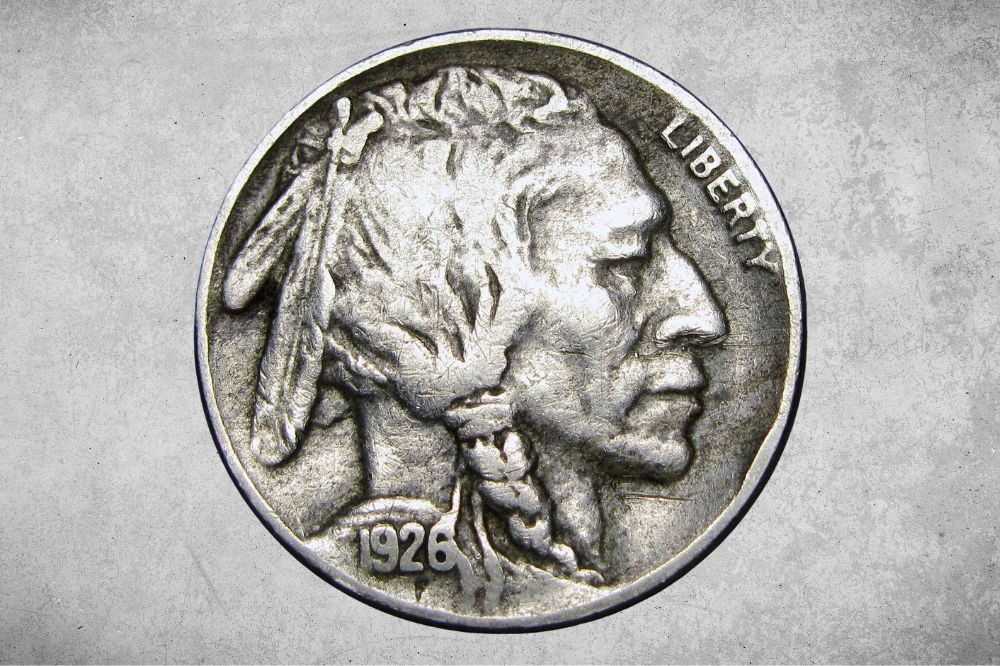The 1926 Buffalo Nickel is a unique and desirable coin prized by both novice and experienced collectors. This classic coin, featuring an American bison on the front and a Native American design on its reverse, has long been admired for its beauty and historical significance.
But what exactly is the 1926 buffalo nickel worth? How much is the difference in value there between poor-condition examples and uncirculated coins?
Read on to find out more about this classic nickel and the different factors that influence its value.
1926 Buffalo Nickel Details
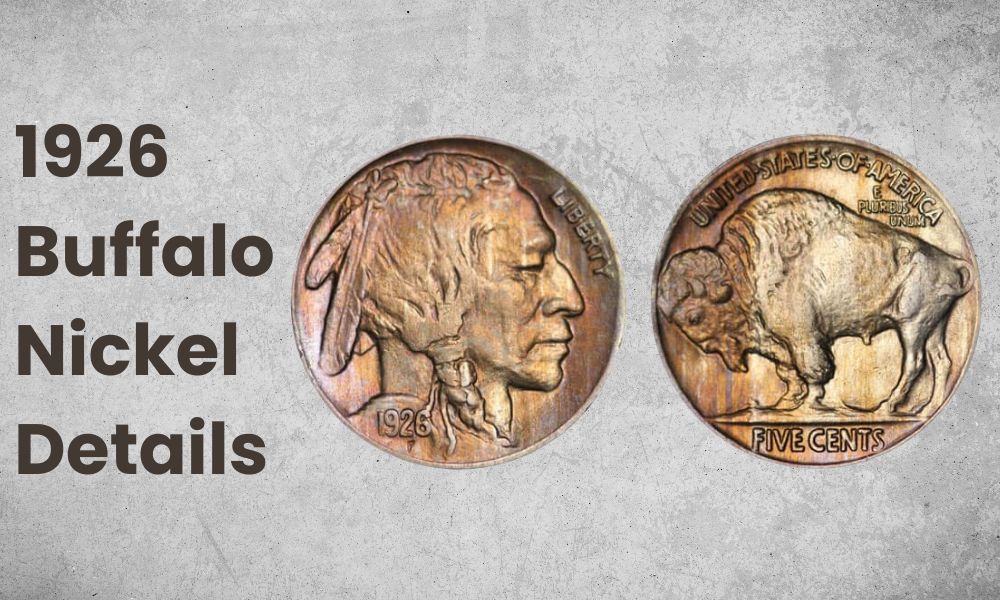
- Category: Indian Head Nickel
- Mints: Philadelphia, Denver, and San Francisco
- Total: 44,693,000
- Obverse designer: James Earle Fraser
- Reverse designer: James Earle Fraser
- Edge: Plain
- Diameter: 21.2 mm
- Thickness: 1.95 mm
- Composition: 75% copper and 25% nickel
- Weight: 5 grams
The 1926 Buffalo Nickel is a classic piece of American coinage. Minted between 1913 and 1938, the Buffalo Nickel was a beloved design among collectors and admirers alike. Not only did it depict one of America’s most iconic animals, but its distinct design helped to define the era in which it was made.
The period from 1913 to 1938 was one of immense change in the United States, and the Buffalo Nickel served as a reflection of this transformation.
The 1926 Buffalo Nickel was minted at three locations: Philadelphia, Denver, and San Francisco. It was designed by James Earle Fraser, an American sculptor, and artist. It is composed of 75% copper and 25% nickel. The copper alloy gives this coin a copper-bronze color, while the nickel adds a slight luster to it. It has a diameter of 21.2 mm and a thickness of 1.95 mm, and it weighs 5 grams.
The total mintage of the 1926 Buffalo Nickel was 44,693,000. The obverse features an American Indian’s face in profile with stars around the rim. The reverse of the coin features an American buffalo standing in front of a tree. It has a plain edge and the words “FIVE CENTS” around the rim.
The design of the 1926 Buffalo Nickel is one of its most recognizable features. It is both timeless and iconic.
Obverse Design
On the obverse of the 1926 Buffalo Nickel is a closeup portrait of an American Indian. According to Fraser, this figure was meant to represent a composite of many different tribes, and it was modeled after three real-life Native American chiefs: Iron Tail of the Sioux, Two Moons of the Cheyenne, and John Big Tree of the Seneca.
Reverse Design
On the reverse of the 1926 Buffalo Nickel is a depiction of an American Buffalo, also known as a bison. This animal was widely used in the Great Plains to feed Native Americans and was a symbol of strength and resilience. The bison was modeled after “Black Diamond,” a resident of the Central Park Zoo in New York City.
Also Read: 15 Most Valuable Nickels Worth Money
1926 Buffalo Nickel Value Chart
|
Date |
Good
(G-4) |
Very Good
|
Fine
(F-12) |
Very Fine
(VF-20) |
Uncirculated
(MS-60) |
Uncirculated
(MS-63) |
| 1926 Buffalo Nickel No Mint Mark Value | 1.42$ | 2$ | 2.81$ | 5.70$ | 36$ | 83$ |
| 1926 “D” Buffalo Nickel Denver Mint Value | 11$ | 20$ | 31$ | 121$ | 399$ | 533$ |
| 1926 “S” Buffalo Nickel San Francisco Mint Value | 24$ | 51$ | 112$ | 427$ | 5128$ | 10,502$ |
1926 Buffalo Nickel Value and Varieties Guides
This classic coin from the 1920s is beloved by collectors for its history and beauty. The 1926 Buffalo Nickel (also known as the Indian Head Nickel) is a treasured piece of Americana that collectors seek to add to their collections. But just how much is a 1926 Buffalo Nickel worth?
The value of a 1926 Buffalo Nickel can vary depending on several factors, including its condition and variety. Here, we’ll give you an understanding of the value and varieties of this vintage coin.
1926 No Mint Mark Buffalo Nickels Value
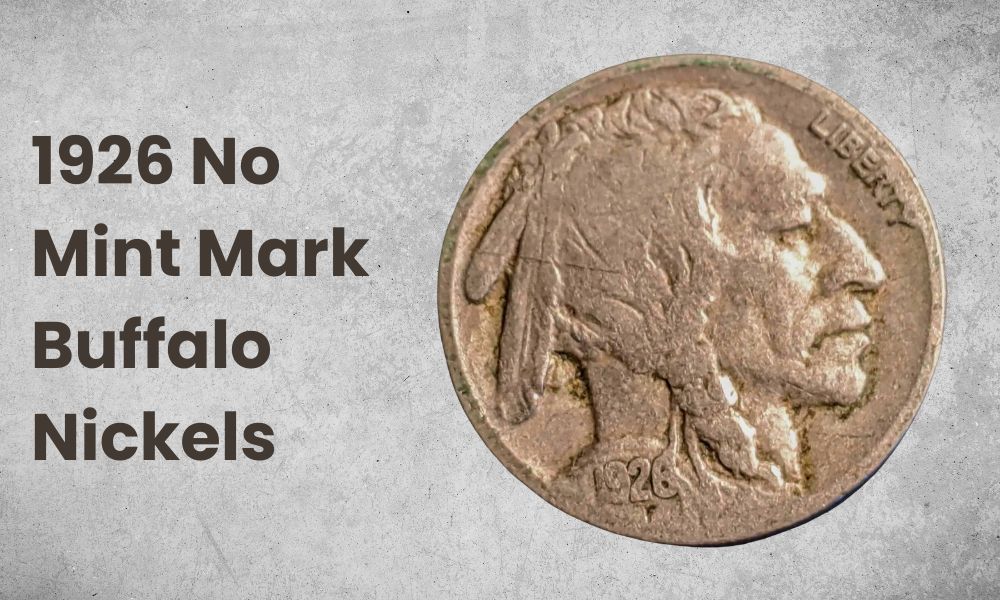
- Type: Indian Head Nickel
- Edge: Plain
- Mint Mark: none
- Place of Minting: Philadelphia
- Year of Minting: 1926
- Face Value: 5 cents
- Price: $1.42 to $83.00
- Minted: 44,693,000
- Designer: James Earle Fraser
The Philadelphia Mint coins are the most abundant of the three varieties. Both circulated and uncirculated versions are readily available, with no mint mark on the reverse.
These coins can be found at various coin dealers and online auctions. The average price for a circulated 1926 Buffalo Nickel ranges from $1.42 to $11.00, while uncirculated examples can vary from $23.00 to $83.00.
1926 “D” Buffalo Nickels Value
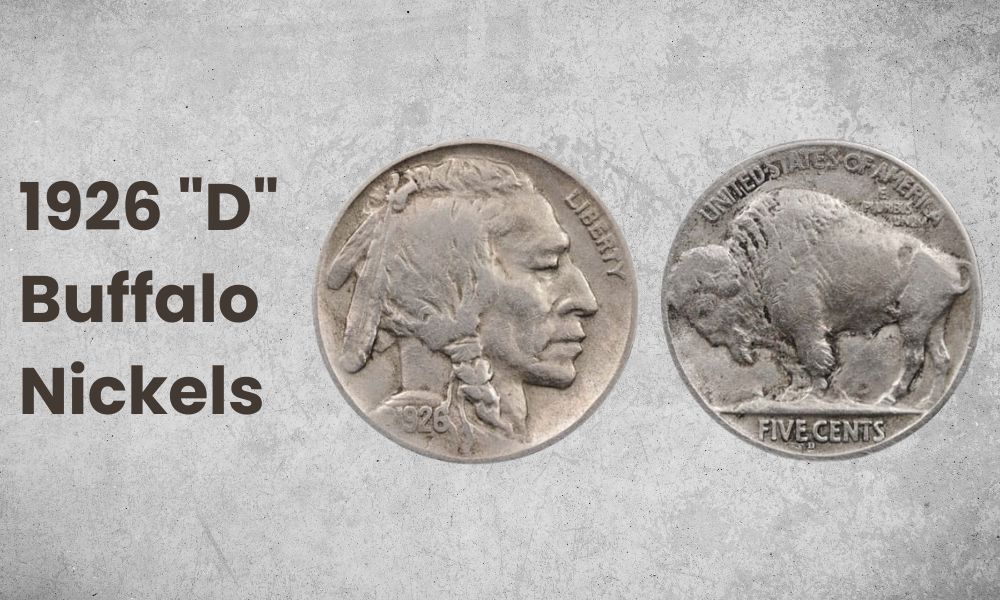
- Type: Indian Head Nickel
- Edge: Plain
- Mint Mark: D
- Place of Minting: Denver
- Year of Minting: 1926
- Face Value: 5 cents
- Price: $11 to $53.00
- Minted: 5,638,000
- Designer: James Earle Fraser
The Denver Mint 1926 Buffalo Nickels feature a “D” mint mark on the reverse side. Collectors highly desired these coins, which are worth more than the Philadelphia Mint coins.
The average price for a circulated 1926 Denver Buffalo Nickel ranges from $11 to $205.00, while uncirculated examples can vary from $300.00 to an astonishing $533.00.
While this variety is rarer, the price difference between circulated and uncirculated coins is much broader.
1926 “S” Buffalo Nickels Value
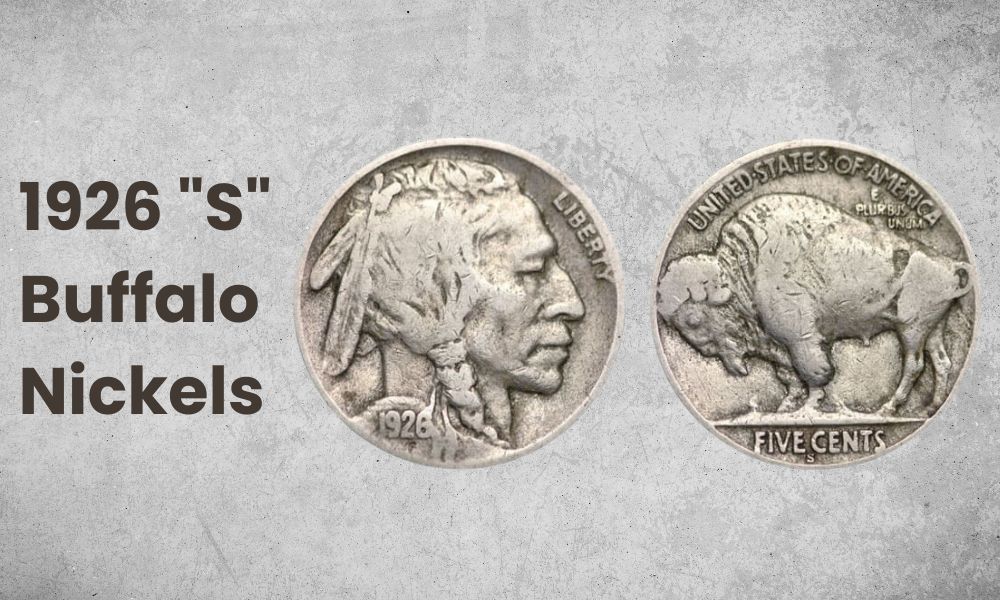
- Type: Indian Head Nickel
- Edge: Plain
- Mint Mark: S
- Place of Minting: San Francisco
- Year of Minting: 1926
- Face Value: 5 cents
- Price: $20.00 to $10000.00
- Minted: 970,000
- Designer: James Earle Fraser
The San Francisco Mint coins feature an “S” mint mark on the obverse side of the coin and are highly sought after by collectors. The 1926 Buffalo Nickel minted in San Francisco is an iconic piece of coinage, representing the beauty and craftsmanship of American currency.
The San Francisco Mint coins were made from an alloy of 75% copper and 25% nickel, giving them a distinctive luster.
The average price for a circulated 1926 San Francisco Buffalo Nickel ranges from $20.00 for a lower-grade specimen to $300.00 for a higher-grade example. A rarer Uncirculated example can be valued up to $10000.00.
However, the value of a 1926 Buffalo Nickel doesn’t stop at its condition or minting location. Several varieties of this coin can add to its overall value. Some of these varieties include Full Steps, Doubled Dies, and Repunched Mint Marks, each of which has unique traits.
Full Steps varieties feature complete steps on the reverse side of the coin, indicating that it has been well-struck and carefully detailed. These coins are valued at a premium and can range from $50.00 to $900.00, depending on the coin’s condition.
Doubled Die varieties, on the other hand, feature doubling of some aspects of the coin. A mechanical error during the striking process resulted in details such as the date and mint mark being doubled. These coins can be worth anywhere from $50.00 to an impressive $10,000.00.
Extremely rare Repunched Mint Mark (RPM) varieties also exist. These coins feature a mint mark punched into the coin twice, resulting in a doubled mint mark. These coins are scarce and valuable, with prices of more than $1000.00.
Also Read: Top 110 Most Valuable Nickels Worth Money
History of the 1926 Buffalo Nickels
James Earle Fraser designed the Buffalo Nickel in 1913 at the behest of President Theodore Roosevelt, who wished to replace the Indian Head cent. The design features a profile of an American bison on the reverse and a portrait of a Native American tribal chief on the obverse.
This coin replaced the Liberty Head Nickel, circulating since 1883. The Buffalo Nickel was released into circulation in 1913 and remained in production until 1938.
The Buffalo Nickel was produced from 1913 to 1938 and was built at three different mints: the Philadelphia Mint, Denver Mint, and San Francisco Mint. During its 25-year production run, the Buffalo Nickel was one of America’s most popular coins due to its distinctive design and metal composition.
Over the years, 1926 Buffalo Nickels have become a collector’s item, and the value of these coins has steadily increased. With its iconic design and historical significance, this coin remains one of America’s most beloved pieces of currency.
1926 Buffalo Nickels Grading
The condition of a 1926 Buffalo Nickel can significantly impact its value. A coin in an Excellent or Uncirculated state will be worth more than a lower-grade specimen. It’s essential to understand how grading works to assess your coin’s worth accurately.
Grading is a method of assessing the condition of a coin and assigning a numerical score. In general, coins graded as having less wear will be worth more than those with more significant signs of wear or damage.
In the United States, coins are graded using the Sheldon scale, which assigns grades from 1 to 70.
1926 Buffalo Nickels Error
1. 1926 Buffalo Nickels DDO or DDR Error
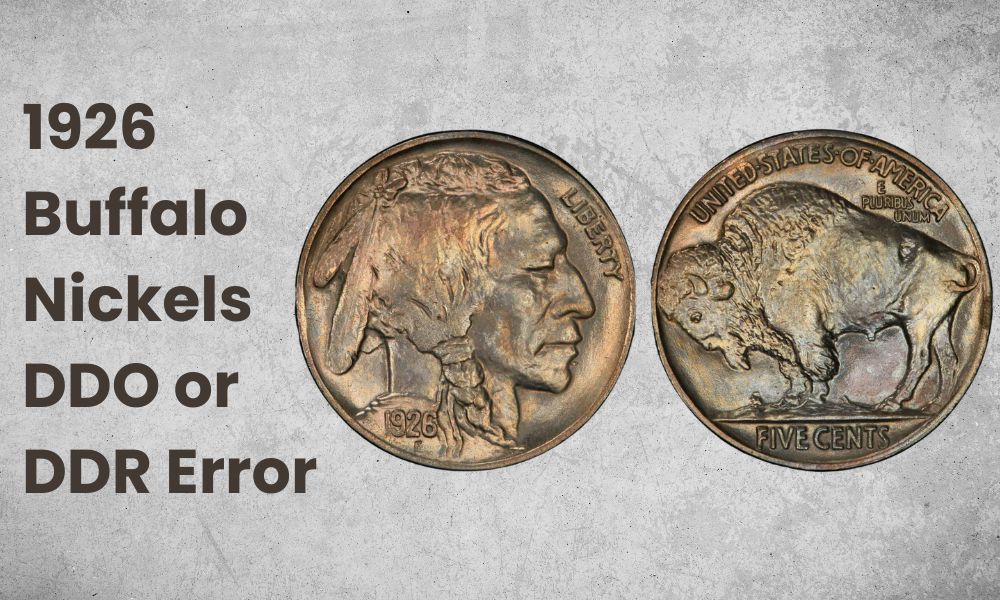
The 1926 Buffalo Nickel errors are considered among the most sought-after coins in the United States. These rare coins feature a doubled die obverse (also known as DDO) or a doubled die reverse (DDR). The value of these coins can be anywhere between $800 and $3,000.
2. 1926 Buffalo Nickel Two-feather Error
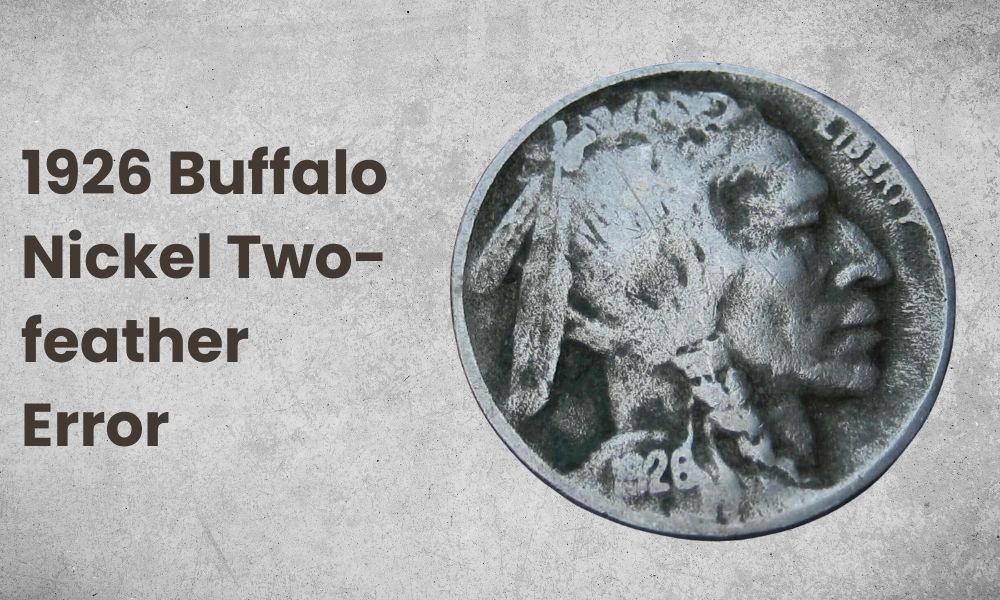
The 1926 Buffalo Nickel Two-feather Errors are also highly sought after. These coins are much rarer than the Three-Feather variety and feature only two feathers in the headdress. It is believed that these coins were struck using a reverse die intended for the regular Buffalo Nickel design, which had three feathers.
This mistake was soon corrected, and no more Two-feather errors were made after 1926. These coins are quite rare and highly sought-after by collectors, with some selling at auctions for thousands of dollars.
3. 1926 Buffalo Nickel 3 1/2 legs Error
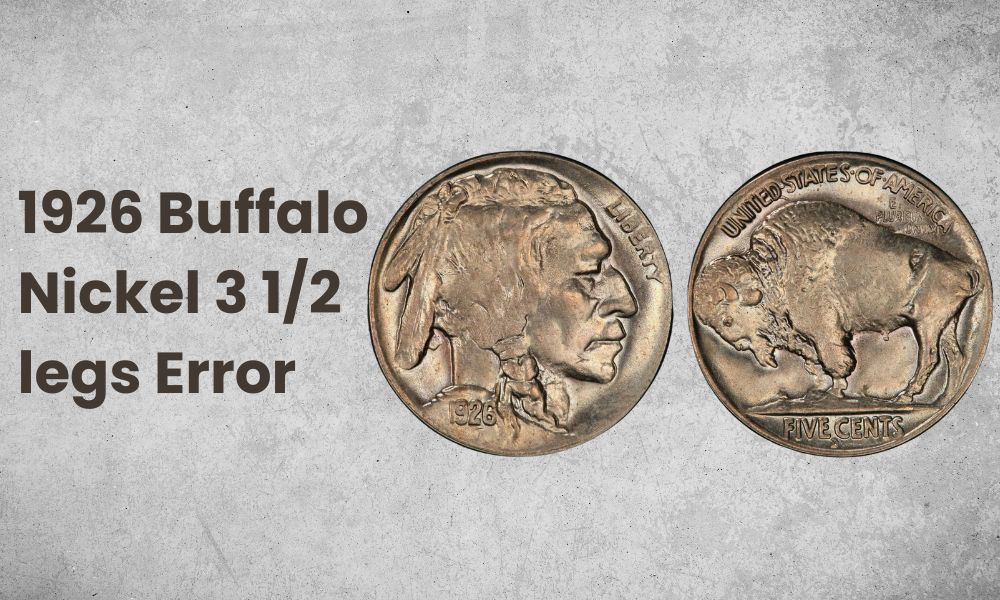
These Errors are a bit more common than in the Two-feather and DDO/DDR varieties. Some 1926 Buffalo Nickels were struck with three and a half legs, where the front left leg is partially erased or broken. These coins are scarce in higher grades and can make an excellent addition to any coin collection.
The Denver Mint was known for producing some of the most beautiful Buffalo Nickels ever made, but it also had coins with errors. From the famous Two Feather variety to the 3 ½ leg error, these coins are sought after by coin collectors worldwide.
FAQs
Where is the mint mark on a 1926 Buffalo Head nickel?
The mint mark for the 1926 Buffalo Head Nickel is on the reverse side of the coin, just below the word “FIVE CENTS.”
What year is a rare buffalo nickel?
The 1926 Two Feather variety and the DDO/DDR Errors are the most sought-after and rare Buffalo Nickels. These coins are quite rare and fetch high values in auctions. The 1936-D three-legged variety is also highly sought after but less valuable than the two feather coins.
The 1937-D is one of the most popular buffalo nickels and is commonly collected by numismatists. It is often found with full details and high grades, making it a desirable coin.
How can you tell if a buffalo nickel is rare?
The best way to tell if a Buffalo Nickel is rare is to look at its condition and mint mark. Coins with no mint mark are generally more desirable, as they were struck at the Philadelphia Mint. Coins with a “D” mintmark are from the Denver Mint and tend to be more valuable.
Look for scratches, gouges, and signs of wear to determine the coin’s grade. Buffalo Nickels in extremely fine or better condition are considered valuable and rare.
Coins with a “7” under the last digit “8” in the date tend to be more valuable due to the limited number released by the mint.
